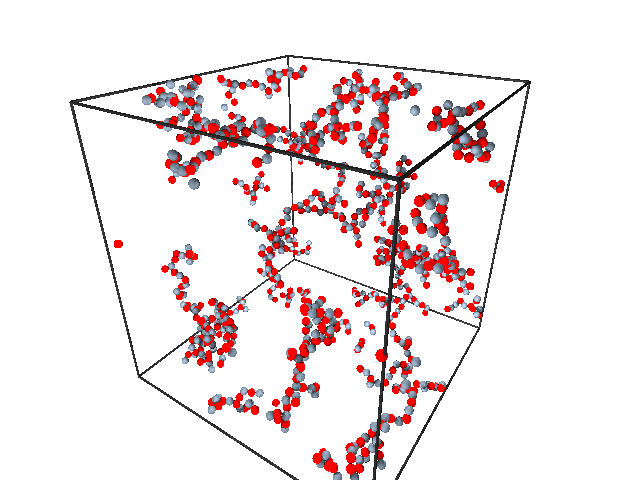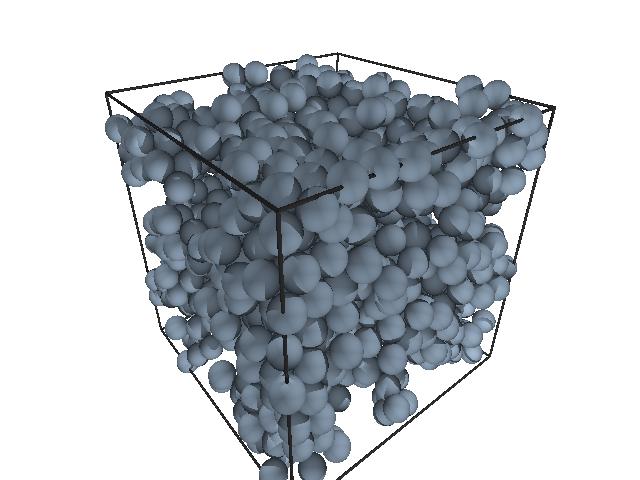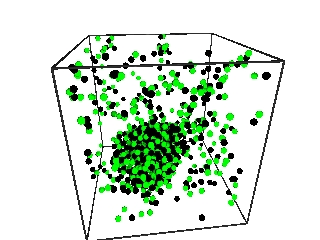| 44. | Aging of a hard-sphere glass: effect of the microscopic dynamics
Antonio M. Puertas
Journal of Physics: Condensed Matter, 22 10121 (2010). Abstract |
| 43. | Colloidal permeability of liquid membranes consisting of hard particles by nonequilibrium simulations
Maria J. Ariza, Antonio M. Puertas
Journal of Chemical Physics, 131 144906 (2009). Abstract |
| 42. | Active and nonlinear microrheology in dense colloidal suspensions
Igor Gazuz, Antonio M. Puertas, Thomas Voigtmann, Matthias Fuchs
Physical Review Letters, 102 248302 (2009). Abstract |
| 41. | Comparison of structure and transport properties of concentrated hard and soft sphere fluids
Erik Lange, Jose B. Caballero, Antonio M. Puertas, Matthias Fuchs
Journal of Chemical Physics, 130 174903 (2009). Abstract
|
| 40. | Phase behaviour of a model colloid-polymer mixture at low colloid concentration
Manuel S. Romero-Cano, Antonio M. Puertas
Soft Matter, 4, 1242 (2008). Abstract |
|
39.
|
Viscoelasticity
and Stokes-Einstein relation in repulsive and attractive colloidal
glasses
Antonio M. Puertas, Cristiano de Michele, Francesco
Sciortino, Piero Tartaglia, Emanuela Zaccarelli
Journal of Chemical Physics, 127 144906 (2007). Abstract
// cond-mat/0705.2988
|
|
38.
|
Bond formation and
slow heterogeneous dynamics in adhesive spheres with long-ranged
repulsion: Quantitative test of mode coupling theory
Oliver Henrich, Antonio M. Puertas, Matthias Sperl,
Johan Baschnagel, and Matthias Fuchs
Physical Review E 76, 031404 (2007). Abstract
// cond-mat/0705.0637
|
|
37.
|
Linking
Phase Behaviour and Reversible Colloidal Aggregation at low
Concentrations:
Simulations and Stochastic Mean Field Theory
Antonio M. Puertas, Gerardo Odriozola
Journal of Physical Chemistry B, 111, 5564 (2007). Abstract
|
|
36.
|
Low
temperature behaviour and glass line of the symmetrical colloidal
electrolyte
Jose B. Caballero, Antonio M. Puertas
Physical Review E, 76 011401 (2007). Abstract
// cond-mat/0701419
|
|
35.
|
Competition
between glass transition and liquid-gas separation in attracting
colloids
A. M. Puertas, M. Fuchs, M.E. Cates
Journal of Physics: Condensed Matter, 19, 205140
(2007). Abstract
// cond-mat/0610542
|
|
34.
|
Aging
in attraction-driven colloidal glasses
Antonio M. Puertas,
Matthias Fuchs, Michael E. Cates
Physical Review E, 75, 031401 (2007). Abstract
// cond-mat/0603666
|
|
33.
|
Density anomaly
and liquid-liquid transition from perturbation
Jose B. Caballero, Antonio M. Puertas
Physical Review E 74 051506 (2006) Abstract
|
|
32.
|
Stability of the
Liquid Phase in Colloidal Electrolytes
Jose B. Caballero, Antonio M. Puertas
Journal of Molecular Structure: THEOCHEM 769 157
(2006) Abstract
// cond-mat/0511666
|
|
31.
|
Dynamical
heterogeneities in an attraction driven colloidal glass
Antonio M. Puertas, Matthias Fuchs, Michael E. Cates
Journal of Non-Crystalline Solids, 352 4830 (2006) Abstract
// cond-mat/051044
|
|
30.
|
Experimental Phase
Diagram of Symmetric Binary Colloidal Mixtures with Opposite Charges
M.S. Romero Cano, J.B. Caballero, A.M. Puertas
Journal of Physical Chemistry B 110 13220 (2006) Abstract
|
|
29.
|
Liquid-gas
separation in colloidal electrolytes
J.B. Caballero, A.M. Puertas, A. Fernandez-Barbero, F. Javier de las
Nieves, J.M. Romero-Enrique, L.F. Rull
Journal of Chemical Physics 124, 054909 (2006) Abstract
// cond-mat/0508259
|
|
28.
|
Structure factor
scaling in colloidal charge heteroaggregation
A.M. Puertas, A. Fernandez-Barbero, F. Javier de las
Nieves
EuroPhysical Journal E 18, 335 (2005) Abstract
|
|
27.
|
Viscoelastic
properties of attractive and repulsive colloidal glasses
Antonio M. Puertas, Emanuela Zaccarelli, Francesco Sciortino
Journal of Physics: Condensed Matter, 17, L271
(2005) Abstract
// cond-mat/0410354
|
|
26.
|
Formation of
clusters in a mixture of spherical colloidal particles oppositely
charged
J.B. Caballero, A.M. Puertas, A. Fernandez-Barbero, F.
Javier de las Nieves
Colloid and Surfaces A, 270, 285 (2005). Abstract
|
|
25.
|
Mode Coupling and
Dynamical Heterogeneity in Colloidal Gelation: A Simulation Study
A.M. Puertas, M. Fuchs, M.E. Cates
Journal of Physical Chemistry B 109, 6666
(2005). Abstract
// cond-mat/0409740
|
|
24.
|
Tagged-particle
dynamics in a hard-sphere system: mode-coupling theory analysis
Th. Voigtmann, A.M. Puertas, M. Fuchs
Phys. Rev. E 70, 061506 (2004). Abstract
// cond-mat/0406036
|
|
23.
|
Oppositely charged
colloidal binary mixtures: a colloidal analogue of the Restricted
Primitive Model
J.B. Caballero, A.M. Puertas, A. Fernandez-Barbero, F.J. de las Nieves
Journal of Chemical Physics, 121, 2428,
(2004). Abstract
|
|
22.
|
Theory and
simulation of gelation, arrest and yielding in attracting colloids
M.E. Cates, M. Fuchs, K. Kroy, W.C.K. Poon, A.M. Puertas,
Journal of Physics: Condensed Matter, 16, S4861
(2004). Abstract
// cond-matt/0403684
|
|
21.
|
Dynamical
heterogeneities close to a colloidal gel
A.M. Puertas, M. Fuchs, M.E. Cates
Journal of Chemical Physics, 121, 2813,
(2004). Abstract
// cond-matt/0412364
|
|
20.
|
Internal structure
of clusters from charge heteroaggregation
A.M. Puertas, A. Fernández-Barbero, F.J. de las Nieves.
Journal of Colloid and Interface Science, 274,
346 (2004). Abstract
|
|
19.
|
Colloidal
aggregation induced by long range attractions
A.M. Puertas, A. Fernández-Barbero, F.J. de las Nieves, L.F.
Rull
Langmuir 20, 9861 (2004). Abstract
|
|
18.
|
Induced
asymmetries in the Heteroaggregation of oppositely charged colloidal
particles
A.M. Puertas, A. Fernández-Barbero, F.J. de
las Nieves.
Journal of Colloid and Interface Science, 265, 31
(2003). Abstract
|
|
17.
|
Simulation study
of Non-ergodicity Transitions: Gelation in Colloidal Systems
A.M. Puertas, M. Fuchs, M.E. Cates
Phys. Rev. E 67, 031406 (2003). Abstract
|
|
16.
|
Multiple glassy
states in simple model system
K.N. Pham, A.M. Puertas, J. Bergenholtz, S.U. Egelhaaf, A.
Moussaïd, P.N. Pusey, A.B. Schofield, M.E. Cates, M. Fuchs,
W.C.K. Poon,
Science 296, 104 (2002). Abstract
|
|
15.
|
Comparative
simulation study of colloidal gels and glasses
A.M. Puertas, M. Fuchs, M.E. Cates.
Phys. Rev. Lett. 88, 098301 (2002). Abstract
|
|
14.
|
Kinetics of
colloidal heteroaggregation
A.M. Puertas, A. Fernández-Barbero, F.J. de
las Nieves.
Physica A, 304, 340 (2002). Abstract
|
|
13.
|
Kinetics of charge
heteroaggregation by Brownian dynamics simulation: role of the
interaction potential profile
A.M. Puertas, A. Fernández-Barbero, F.J. de
las Nieves.
Colloids and Surfaces A, 195, 189 (2001).
Abstract
|
|
12.
|
Colloidal
aggregation induced by attractive interactions
A.M. Puertas, A. Fernández-Barbero, F.J. de
las Nieves.
Journal of Chemical Physics, 115, 5662
(2001). Abstract
|
|
11.
|
Charged colloidal
heteroaggregation kinetics
A.M. Puertas, A. Fernández-Barbero, F.J. de
las Nieves.
Journal of Chemical Physics, 114, 591
(2001). Abstract
|
|
10.
|
Agregación
de sistemas coloidales con cargas opuestas: Efecto de la
concentración relativa de partículas
A.M. Puertas, A. Fernández Barbero, F.J. de
las Nieves.
Boletín de la Sociedad Española de
Cerámica y vidrio, 39, 441 (2000).
(There is not electronic version of this journal).
|
|
9.
|
Colloidal
aggregation under steric interactions: Simulation and experiments
M.S. Romero-Cano, A.M. Puertas, F.J. de las Nieves.
Journal of Chemical Physics, 112, 8654
(2000). Abstract
|
|
8.
|
Aggregation
between oppositely charged colloidal particles
A.M. Puertas, A. Fernández-Barbero, F.J. de
las Nieves.
Progress in Colloid and Polymer Science, 115, 55
(2000). Abstract
|
|
7.
|
Brownian dynamics
simulation of diffusive mesoscopic particle aggregation
A.M. Puertas, A. Fernández-Barbero, F.J. de
las Nieves.
Computer Physics Communications 121-122, 353
(1999). Abstract
|
|
6.
|
Colloidal
stability of polymer colloids with variable surface charge
A.M. Puertas, F.J. de las Nieves.
Journal of Colloid and Interface Science 216,
221 (1999). Abstract
|
|
5.
|
Particle
interactions in colloidal aggregation by Brownian dynamics simulation
A.M. Puertas, J.A. Maroto, A.
Fernández-Barbero, F.J. de las Nieves.
Physical Review E, 59 1943
(1999). Abstract
|
|
4.
|
On the kinetics of
heteroaggregation versus electrolyte concentration: comparison between
simulation and experiment
A.M. Puertas, J.A. Maroto, A.
Fernández-Barbero, F.J. de las Nieves.
Colloids and Surfaces 151, 473 (1999). Abstract
|
|
3.
|
Theoretical
description of the absorbance versus time curve in a homocoagulation
process
A.M. Puertas, J.A. Maroto, F.J. de las Nieves.
Colloids and Surfaces 140, 23 (1998). Abstract
|
|
2.
|
A
new method for calculating kinetic constants within the
Rayleigh-Gans-Debye approximation from turbidity measurements
A.M. Puertas, F.J. de las Nieves
Journal of Physics C 9, 3313 (1997) Abstract
|
|
1.
|
Study
of the singular anharmonic potentials by the analytic continuation
method
E. Buendia, F.J. Gálvez, A. Puertas.
Journal of Physics A 28, 6731 (1995). Abstract
|
 Colloidal Heteroaggregation
between oppositely charged particles
Colloidal Heteroaggregation
between oppositely charged particles  Glass-like arrest
in colloidal gels. Simulations and comparison with Mode Coupling Theory
Glass-like arrest
in colloidal gels. Simulations and comparison with Mode Coupling Theory

